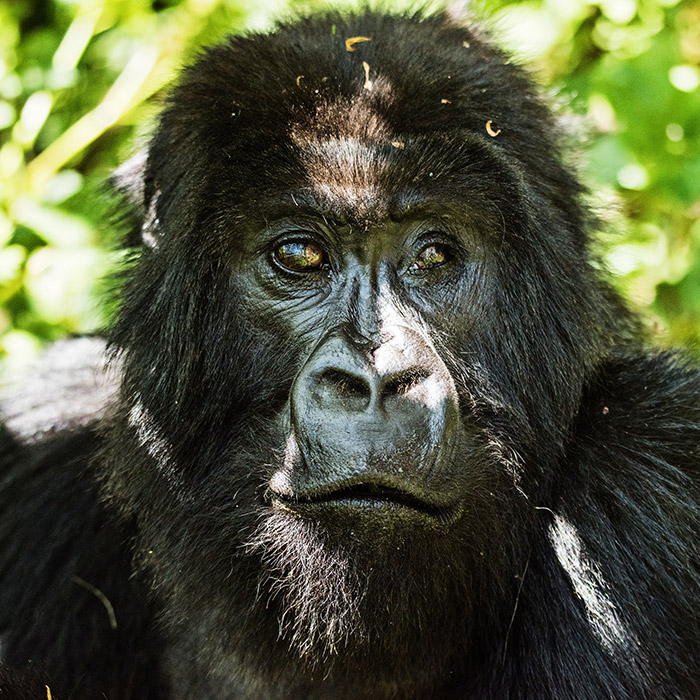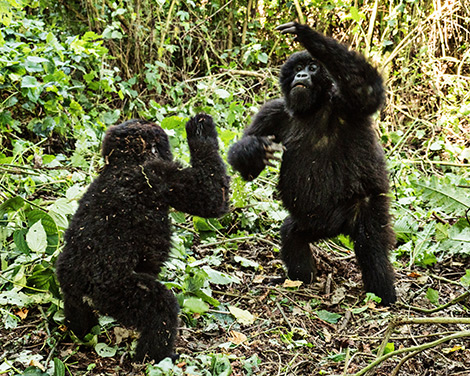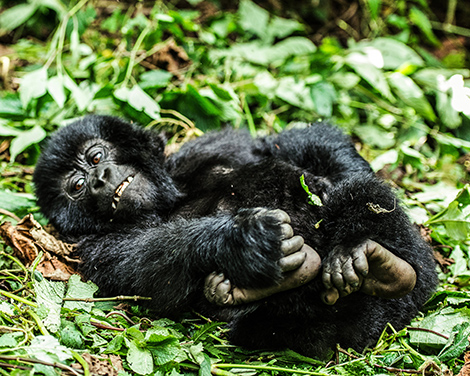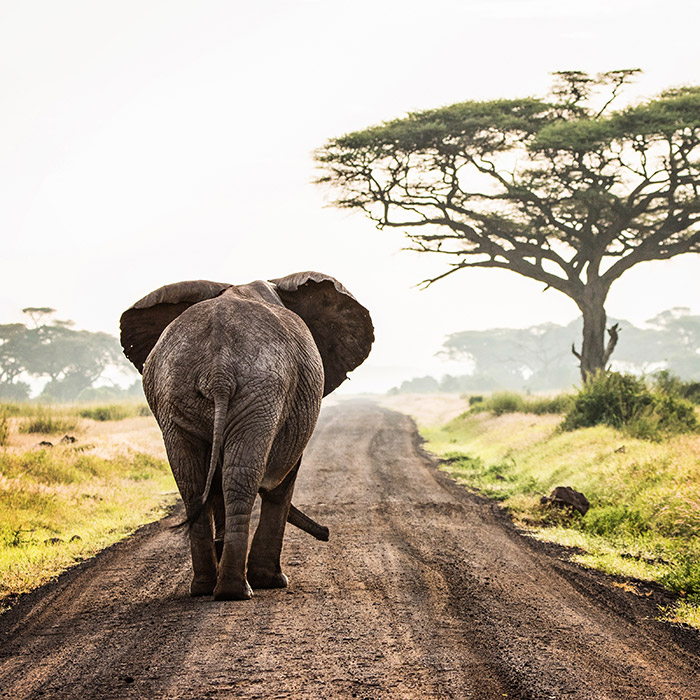
Love and Adventure
Ricker, who has been to all seven continents, 48 countries and 42 states, trains her lens on an elephant. See more of her photos.
View Her PhotosWildlife photographer Kathleen Hertel Ricker captures animals in their natural habitats.
Our guides swung machetes back and forth, making a path through the jungle. Sweat dripped down my face. My knees shook with pain as I tried to balance myself in the mud. Mosquitoes and stinging nettles attacked my bare skin. We had been hiking for over two hours, but it seemed like forever.
But this is what I craved. Four years ago I set a goal — to see wildlife in their natural habitat and use my photography to educate others about animals in the wild, not behind bars in a zoo.
Since then, I have been to all seven continents, swum with Orcas in Norway, encountered penguins in Antarctica and been surrounded by elephants and lions. This was my fifth trek to see gorillas in Africa and my second trip to Virunga National Park — one of the few places to spot mountain gorillas in the wild.
This part of Congo still has problems with poaching. Gorillas are killed mostly for meat but also for their land.
Today I was going to meet a family of nine gorillas — three silverbacks, four little ones and two females.
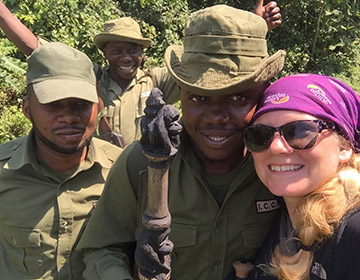
The family was just around a bend. Our group donned face masks to prevent the transfer of germs between us and the gorillas. Humans and gorillas are so close genetically that even a small cold can be transferred back and forth between the two species.
I readied my three cameras — one with a lens for close ups, another for portraits and a third point-and-shoot model for video. We had to stay a minimum of six feet from the gorillas but the gorillas can move as freely as they please. The little ones, like all children, are often curious and will venture a bit closer.
We started toward the family, when we heard the grunt of a silverback in the bushes. He was making his presence known. Our guide grunted back, letting him know it was safe.
As we turned the corner, we saw the beautiful Munyaga Group, lying under the trees. Bilali, the oldest female, was in the center watching over three wrestling babies.
She was so beautiful. Her facial expressions reminded me of all tired mothers whose youngsters refuse to nap. I watched as her eyes grew heavy and closed for just a minute until one of the little ones jumped on her. Then Bilali and I made eye contact, staring at each other. I just melted into her big brown eyes wondering what was going through her mind.
In this video Kathleen Hertel Ricker talks about how her undergraduate experiences at Towson University fueled her passion for photography.
These gorillas are habituated — familiar with humans — but still extremely wild. Those not habituated typically just move or hide when humans are nearby. Many gorilla families associate humans with poaching or kidnapping their babies, which end up in zoos.
Yet even habituated groups are extremely protective of newborns. While trekking with gorillas in Uganda, our guide got too close to one of the infants. The mother screeched in alarm and within seconds the silverback crashed through the brush, ran up the hill and started swiping at our guide. Our guide was able to calm the silverback so we could continue our experience, but the male gorilla eyed us constantly, making sure his family was safe.
Habituation takes two to three years, a process where researchers come across wild gorillas and essentially join the family. Trekkers eat like them, travel with them, behave like them. They learn about each gorilla in the group — their behaviors and characteristics — and give them a name based on their personalities. When the mountain gorillas become accustomed to the humans, other scientists, conservationists or journalists are brought for visits. If everything goes well, the treks are made available to the public.
There are fewer than 880 mountain gorillas left on our planet, according to the World Wildlife Fund. They are found only in the Virunga volcanoes which span the borders of Rwanda, Uganda and the Democratic Republic of the Congo, and in Bwindi Impenetrable National Park in Uganda.
“ The one hour I get to spend with the gorillas is never enough time. I could watch them all day. ”
I’ve seen gorillas at each location but the Virunga Park in the Congo is my favorite spot. Bwindi National Park, home to 480 gorillas, is a close second with its beauty and tropical feel.
Twice in nine months I visited Bwindi’s Nshongi Group, named after the Nshongi River, where this group was first found. This is the largest family of gorillas in Bwindi, with about 18 members that often split off into smaller families.
In June 2016, while trekking with the Nshongi Group, I met a little guy, Raha (which means “enjoys”), who was about three or four years old. He was jumping around in the tree tops banging his chest and then falling down rolling in the leaves laughing.
Raha loved our attention. He climbed from tree to tree making sure that we were watching him.
In March 2017, I was back with the Nshongi group and within minutes I saw Raha again.
Tired from the uphill trek, I sat in the brush and photographed one of the mothers and her baby as she cuddled him. Suddenly, I saw Raha coming right at me. I stayed still to see what he would do. My guide told me to pick up my camera so he wouldn’t grab it. Raha moved right in front of me and reached for the camera, but I got it before he had a chance to grab it. Then he reached out and touched my leg. My heart was racing. Then he did it again!
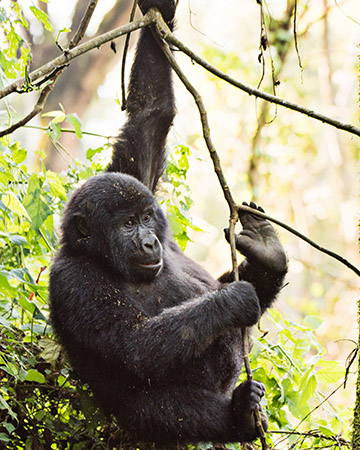
As he moved to sit right next to me, I was teary and barely breathing. For an animal lover this was the ultimate moment. I felt like I was Dian Fossey, a zoologist and gorilla researcher, who lived and died with her gorillas.
Each trek with these beautiful animals has been different and magical. The one hour I get to spend with the gorillas is never enough time. I could watch them all day. The more I look at them the more similarities I find between gorillas and humans, from the way we move our hands to the way we interact with our young. The idea of a world without gorillas is heartbreaking.
We must spread the word and educate people about how precious these animals are and how vital their habitat is for their survival. My hope is that in five years we will have 1,000 gorillas, until some day they will no longer be endangered.
Kathleen Hertel Ricker is a wedding photographer and animal advocate. She hopes her photos from adventures to Africa, India and other global destinations will “educate people about how they can save the planet.”
This story was originally published in the fall 2017 Towson University magazine.
